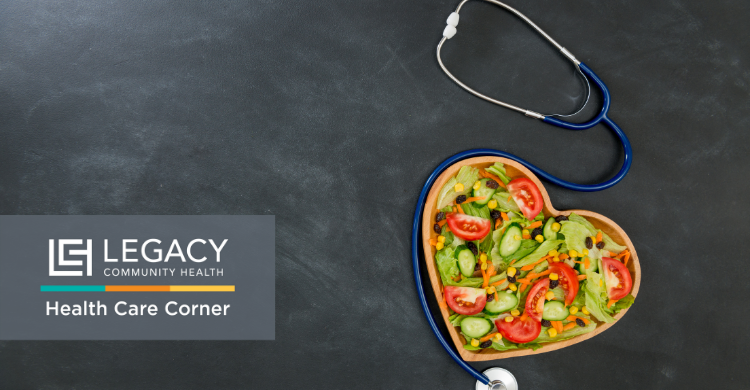Managing your high blood pressure can be such a pain. Fortunately, with a better understanding of nutrition’s role, it doesn’t have to be.
By Rita Zapien, Registered Dietitian
According to the American Heart Association, about half of Americans have high blood pressure, known as hypertension. Many people don’t know they have it because most of the time, there are no symptoms. This is why high blood pressure is often called the “silent killer.”
Controlling sodium intake is crucial for hypertension management. Most people with high blood pressure should aim for no more than 1,500 to 2,000 mg per day of sodium. To help you visualize what that might look like, just one fast food meal can provide more than the suggested daily budget for sodium. With that in mind, try to limit how often you eat out from your favorite drive-thrus.
However, there are many foods higher in sodium that don’t taste salty. The top three sources of sodium in our diets are:
- Bread products
- Cold cuts and cured meats
- And pizza
A hamburger bun can have over 250 mg sodium. A hot dog can have over 500 mg sodium!
Here are some additional nutritional tips you can take as you work to manage your blood pressure:
Eat a variety of fruits and vegetables, especially those high in potassium. Potassium relaxes the walls of the blood vessels and it helps lower blood pressure. Foods high in potassium include cooked spinach and broccoli, green leafy greens, avocado, tomatoes, potatoes or sweet potatoes, oranges, and bananas.
Opt for whole grains such as 100% whole wheat bread and pastas, oatmeal, brown rice, quinoa, and stone-ground grits. If you have white rice, be sure to include vegetables at your meal.
Eat a variety of protein-rich foods such as seafood, lean meats and poultry, eggs, nuts, seeds, soy products, and legumes such as beans, lentils, and chickpeas.
Choose lower-fat dairy products, especially fermented dairy products like plain yogurt or kefir. Limit or avoid sweetened dairy products.
Consider adding nutritious fats such as omega-3s from fatty fish like salmon or nuts and seeds (walnuts, ground flaxseed or chia seeds).
Decrease intake of foods high in sodium and added sugars. It is best to limit or avoid highly processed snacks such as chips, cookies, crackers, cereals, and salted nuts with added oils. Other highly processed foods we suggest limiting or avoiding are smoked, cured, salted or canned meats such as bacon, deli ham, sausage, hot dogs.
Decrease your intake of sweetened beverages such as sodas, fruit juices, sweet tea, chocolate milk, energy drinks, electrolyte or sports drinks, smoothies with added sugars, or lemonade. Consider replacing these drinks with drinks that say: unsweetened, zero sugar, diet, light, or no added sugar on the label.
Some canned foods such as canned vegetables, soups, sauces and pickled foods. Try canned foods that say: no salt added, low or lower sodium, reduced sodium on the label.
Ready-to-eat foods and fried foods such as frozen meals, pizzas, nuggets, ramen noodles, French fries, breaded meats, etc. should be reduced or avoided, as many of these are high in sodium.
Broths and stocks are typically high in sodium, so consider choosing lower sodium alternatives.
Other common sources of sodium include sports drinks, Himalayan salt, pink salt, sea salt, seasonings like Tony Chachere’s, Knorr, and garlic salt.
Once you know what you’re looking to avoid – but more importantly, what tasty alternatives to begin adding into your diet in place of them – managing your hypertension begins to feel less and less like an uphill battle. Remember: Your primary care provider and nutritionist are here to help! Remember to ask questions during your visits. We’re here to help!
To schedule an appointment with your Legacy provider, call 832-548-5000 or schedule online.

